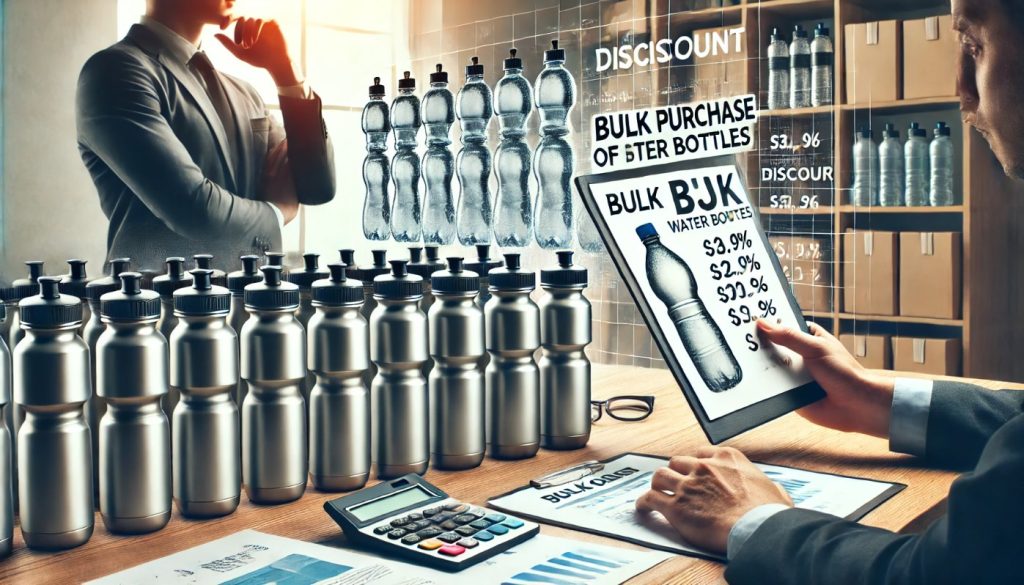Offering discounts to bulk buyers is a powerful strategy to attract new customers, close large deals, and establish long-term relationships in the competitive water bottle market. However, the challenge lies in striking a balance between offering discounts and maintaining healthy profit margins. For water bottle businesses, especially those dealing in bulk sales, crafting the right discount strategy is crucial to both attracting high-volume clients and ensuring sustainable profitability.
Bulk Water Bottle Pricing
What Drives Bulk Water Bottle Pricing?
Bulk pricing involves offering a reduced rate for large quantities of products, and the rationale behind this is simple: customers who purchase more products are usually expected to get a better price per unit. However, the reduced price per bottle should still allow for a reasonable margin that covers production, shipping, and other operational costs.
Several factors impact the pricing of bulk water bottles:
- Production Costs: This includes material costs (such as plastic, glass, or stainless steel), manufacturing labor, and packaging.
- Order Size: Larger orders often lead to reduced costs due to economies of scale. As the order quantity increases, the cost per unit can decrease.
- Customization Costs: Branded or customized water bottles (e.g., logo printing, special colors, or designs) often incur additional costs.
- Shipping and Logistics: Bulk orders may be costly to ship, so you need to account for these expenses in your pricing strategy.
- Competition: The price at which competitors are selling similar products in bulk can influence your pricing decisions.
Cost-Volume-Profit (CVP) Analysis
Understanding how costs, volume, and profit interact is crucial when offering discounts. CVP analysis allows you to determine the number of units you need to sell at different price points to cover costs and achieve a desired profit. This approach helps to identify the minimum price you can offer while ensuring your business remains profitable.
Key Considerations for Offering Discounts
While discounts can drive sales and build long-term relationships, they need to be strategically structured to avoid eroding your profits. Key factors to consider when deciding how much discount to offer include:
- Minimum Order Quantities (MOQs): Offering discounts on larger orders ensures that the scale of the discount is justified by the size of the purchase.
- Profit Margins: Ensure that the discount does not significantly reduce your profit margin. You need to calculate how much margin you can afford to lose without jeopardizing your business’s financial health.
- Customer Loyalty vs. One-Time Sales: If you are offering discounts to build a loyal customer base, consider how those discounts will translate into repeat sales and whether the initial discount is sustainable.
- Sustainability and Brand Positioning: If your brand is positioned as a premium product, offering too many discounts can affect your image and devalue the product in the eyes of consumers.
Types of Discounts for Bulk Water Bottle Buyers
Volume-Based Discounts
Volume-based discounts are among the most common discount strategies for bulk buyers. This approach reduces the price per unit as the order quantity increases, creating a strong incentive for customers to purchase larger quantities.
Tiered Volume Discounts
One way to structure volume-based discounts is through tiered pricing. For example:
- 100-499 units: 5% discount
- 500-999 units: 10% discount
- 1000+ units: 15% discount
This type of discount allows you to offer lower prices for customers purchasing larger quantities without sacrificing your margins. By breaking the discount into tiers, you can still maintain profitability on smaller orders while encouraging larger purchases.
Bulk Order Thresholds
Setting minimum order thresholds for discounts can also help protect your margins. For example, you might only offer a 10% discount for orders over 500 units, ensuring that you are still covering your costs while providing an incentive for bulk purchasing.
Seasonal or Promotional Discounts
Another way to offer discounts without losing margins is through limited-time seasonal promotions or marketing campaigns. These discounts can help clear out inventory or attract attention during slower sales periods.
Time-Sensitive Offers
Seasonal or time-limited offers can create urgency for bulk buyers without compromising your regular pricing strategy. For example, you might offer a 15% discount for bulk orders placed within a specific month or during a particular season (e.g., back-to-school season or holiday sales). Since the discount is temporary, customers are more likely to act quickly, and you can still maintain your standard prices during off-seasons.
Marketing Campaign Partnerships
Partnering with a corporate client or running a joint marketing campaign can allow you to offer discounts without significantly affecting your margins. This can be beneficial for businesses that want to reach a broader audience through a co-branded partnership. You may offer discounts on bulk orders for corporate clients while still benefiting from the visibility and marketing support provided by the campaign.
Early Payment Discounts
Early payment discounts incentivize customers to pay for their bulk orders upfront or within a shorter time frame. Offering a small percentage discount (e.g., 2-5%) on the total order price for early payment can improve cash flow and reduce the financial burden on your business without significantly affecting your margins.
Pros of Early Payment Discounts
- Improved Cash Flow: Early payment discounts encourage customers to settle their bills sooner, which can improve liquidity and reduce the need for financing.
- Reduced Risk of Non-Payment: By offering a discount for immediate payment, you mitigate the risk of delayed payments or bad debt.
Loyalty Discounts for Repeat Bulk Buyers
Loyalty discounts reward customers who make frequent purchases or who commit to long-term bulk orders. Offering a discount to returning customers can help retain business and foster strong, ongoing relationships.
Volume Rebate Programs
A volume rebate program rewards customers based on their cumulative purchases over a set period (e.g., annually). For example, after purchasing a certain amount of water bottles throughout the year, a customer could receive a rebate or discount on future orders. This program motivates bulk buyers to return regularly, securing long-term business while maintaining profitability.
Balancing Discounts with Profit Margins
Calculating the Impact of Discounts on Margins
When offering a discount to bulk buyers, it’s essential to calculate how the discount affects your overall margins. Here’s a simple way to understand the impact:
- Determine the cost per unit: This is the amount it costs you to produce one water bottle, including material, labor, packaging, and overhead.
- Set your standard selling price: This is the price you usually sell your water bottles for, without any discounts.
- Offer the discount: Apply the discount percentage to the selling price to determine the new selling price.
- Calculate the new profit margin: Subtract the cost per unit from the discounted price to determine your profit per unit. Then, divide this by the selling price to find your profit margin.
By doing this for different discount scenarios, you can assess how much room you have to offer discounts without undermining your profitability. Be mindful that while discounts can help increase sales volume, they should not lower your margins to a point where your business becomes unsustainable.
Implementing Effective Discount Rules
Establish clear rules for offering discounts that align with your business objectives. These rules should cover:
- Discount Eligibility: Specify the minimum order quantities or other requirements that customers must meet to receive a discount.
- Discount Timing: Define the duration of promotional discounts and when volume-based discounts are applied.
- Customization Limits: Determine whether customizations (e.g., logos or special designs) will be included in the discount or if they will incur additional fees.
- Discount Caps: Avoid offering excessive discounts by setting a cap on the maximum discount percentage.
Clear guidelines will help you maintain control over your pricing and ensure that discounts do not negatively impact your bottom line.
Using Discounts to Increase Average Order Value (AOV)
One strategy to maintain margins while offering discounts is to tie the discount to an increase in the average order value (AOV). For example, instead of offering a straight discount on the product, offer a discount when customers buy a certain quantity or value of water bottles.
For instance, you could offer a 10% discount for orders over $1,000. This not only incentivizes larger orders but also ensures that your average transaction remains high enough to absorb the discount without losing profitability.
Offer Bundled Discounts
Bundling is another great strategy to offer discounts without significantly hurting your margins. By grouping related products together (such as a set of branded water bottles and a carrying case or water bottle cleaning kit), you can offer a discount on the entire bundle. This tactic adds value for the customer while ensuring that the bundled price still covers your costs.
Bundled Discount Example
For example, offer a bundle of 100 water bottles along with customized carrying cases for a discounted price of $1,500 (down from the original price of $1,800). The cost of the carrying cases is lower than the discount, so your overall margin remains protected, while the customer perceives the added value of the bundle.
Set Clear Expectations with Corporate Clients
When offering discounts to corporate clients, especially for large bulk orders, make sure to communicate the terms clearly. Be upfront about the discount structure, payment terms, and any conditions that need to be met (e.g., minimum order quantities or delivery schedules). This ensures that the discounting process does not result in confusion or misalignment between expectations and outcomes.
By structuring your discount offers thoughtfully, you can attract bulk buyers, increase sales volume, and maintain healthy profit margins. Understanding your costs, implementing effective discount rules, and continuously assessing the impact of discounts will help you achieve a balance that benefits both your customers and your business.







